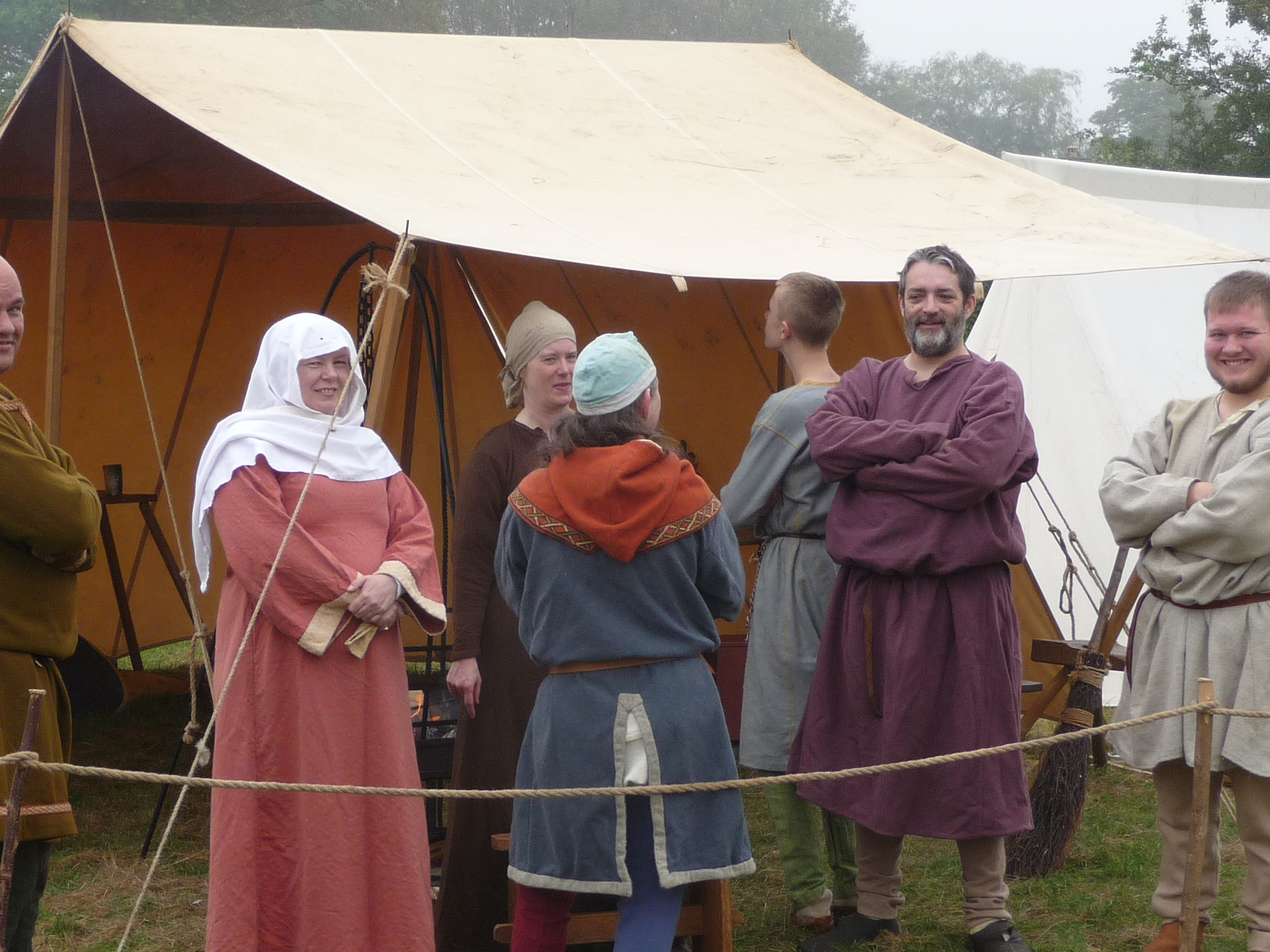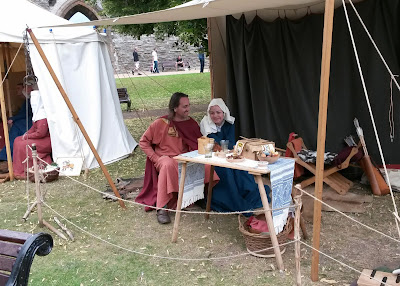Last weekend De Vey was invited to do a Norman show for the Dog Rose Trust in Shropshire.
Although it's a bit of a way for us, we had a good turnout.
 |
| The De Vey colour chart. |
It was rather warm last weekend, so Stephen and Simon (second from the end on the left and right respectively) both chose to portray lower status characters than they might otherwise do so that they could get away with wearing fewer layers. They are therefore just wearing tunics and braies so they didn't have to wear trousers or shoes. I dressed up for the photo, but I'm afraid I took advantage of running a food display and helping with lunch to play a servant doing kitchen chores, which enabled me to tie my wimple back and hoist my dress up slightly, keeping me marginally cooler. At the other end of the scale, Osgyth and Clare are in their nice posh clothes (Osgyth in orange, Clare is sporting a straw hat) and Tancred next to her is still partly in armour after the afternoon battle.
 |
| Symon is already far too hot sitting in the shade at 9am, let alone fighting in the blazing sun at 4pm. Photo by Caroline Williams. |
Never mind danger on the battlefield, I think our warriors were brave just to go on and face heat exhaustion. As a 13th century show, this meant that the knights in full armour were wearing a full-length padded cloth gambeson (to the knee and the wrist), covered by full length mail, with mail covering their legs, mail gloves, topped by a padded linen coif (the baby bonnets the men are wearing in the photo above), mail coif on top, and a bucket helm (shown below). Over the top of this went a surcoat, a garment brought back from the Crusades, where the knights realised that it helps stop metal armour heating up too much. As one who melted simply waiting by the side with water wearing little more than a linen dress and wimple, I didn't envy them!
 |
| Conical helms in the armoury, with an upside down bucket helm in the middle and another at the back left of the table. Photo by Caroline Williams. |
Most of us were wearing linen to keep cool, which has the added advantage of being hard-wearing and easily washable without risking shrinkage, so many of us washed our clothes in the evening and left them to dry in the evening. This is in fact one of the principles of early medieval clothing: linen would be worn as an under layer (under tunics, underdresses, braies) because it could be easily washed, whereas the overtunic would be made of wool, and would rarely be washed.
 |
| Early medieval laundry. Photo by Caroline Williams. |
We took an extensive living history display to this show.
Trevor took his pole lathe, as shown below. I briefly discussed the lathe in my post on
Stoke Potteries, but here you can see it properly in use. The horizontal segment of wood with a string round it is the piece which is being shaped. Trevor is holding a chisel against this piece of wood, and as he works the foot pedal, the piece being shaped is rotated, allowing him to hold the chisel in one place while still chiselling away at 360 degrees of the piece to be shaped.
 |
| Trevor using a pole lathe. Photo by Rosemary Watson. |
Cuthwyn brought her firelighting kit. Below you can see the dry grass, flints, and charred linen.
 |
| Fire-lighting kit. Photo by Caroline Williams. |
Clare brought her embroidery. The first image shown below is based on the Bayeaux Tapestry. The colour scheme is authentic: the Anglo-Saxons would quite happily give a horse blue legs to indicate that they were behind and shaded. The gentleman on horseback is a Norman, as evidenced by his short hair.
 |
| Image based on the Bayeaux Tapestry. Photograph by Caroline Williams. |
Below is a new design Clare is working on: St Catherine. St Catherine was martyred on a wheel, therefore this is her symbol and is included in the design to identify her.
 |
| St Catherine and her wheel. Photo by Caroline Williams. |
Staying on the textiles theme, Osgyth brought her spinning materials. Below you can see the unprocessed sheep's wool. To the right are the metal combs which were used to disentangle and clean wool. Combs are one of the most ancient methods of cleaning fleece: carders were not introduced until much later. The combing process pulls out the long staples, separates them, and aligns them in the same direction so that they are easier to spin. Pieces of dirt and the shorter staples remain caught in the anchor comb to be discarded.
 |
| Combed and uncombed wool, ready for spinning. Photo by Caroline Williams. |
Towards the left of the basket are drop spindles, nestling below a lucet. Drop spindles have been used to spin fibre for millennia, and are still used today in the Andes and parts of Afghanistan. The spinning wheel was not invented until the 13th century and did not become common in Europe until the late medieval period. Spinning on a drop spindle is a time intensive process which all the but richest in society would have participated in in the early medieval period. With a man's tunic requiring approximately 8 miles of thread, spinning was an essential skill that required as many spinners as possible.
Once spun, fibre is dyed. Below you can see Osgyth's basket of naturally-dyed fibres. We often imagine the medieval period as characterised by browns and greys; if you couldn't afford to dye your clothes at all you might well be wearing a very restricted colour pallet, but the bright yellow and lighter green shown below are comparatively easily produced, as they are made from weld, a plant which grows widely throughout Britain and which does not require complex processing or selection of a particular part of the plant. Similarly the pinks can be produced from madder which also grows widely, so even someone comparatively poor could wear quite bright colours provided they had the time to harvest the plants and dye the fibre.
 |
| Add caption |
Once spun, fibre can be used for a number of things. The most well known is weaving. Shown below is a warp-weighted loom, one of the oldest types of loom. The origin of the name is clear when you look at the photo below: the warp threads have weights on them to keep them hanging straight and minimise tangling. You may notice that the cloth on the loom is comparatively narrow: this is because unless you have two weavers, the maximum width of cloth you can weave is an arm's length, as you have to pass the "shuttle" (bearing the weft thread, shown slotted into the left hand-side of the loom) from one side to another. As as result of this constraint, early medieval clothes were typically constructed from a rectangle of cloth with a hole cut for the head, with gores added at the side to increase the width, as this makes very efficient use of the cloth you can manufacture.
 |
| Osgyth's warp weighted loom. Photo by Caroline Williams. |
Somewhat less well-known is tablet weaving, although this is an equally ancient technique, used to make narrow strips of cloth. The braid is made by turning the square tablets you can see in the middle of the loom below to change the position of the warp threads and then pulling a weft thread through.
 |
| Osgyth's tablet weaving loom. Photo by Caroline Williams. |
Each tablet has (usually) four holes through which fibre is threaded and by threading a tablet with different colours or turning them in different sequences, different patterns can be obtained. You can see samples of these below.
 |
| Samples of Osgyth's tablet weaving. Photo by Caroline Williams. |
Finally, and not very well known at all, is sprang Sprang is a method of interlinking warp threads to form a type of net, which can be used as a bag or as a hair net, to give just two examples. You can see Osgyth's sprang loom propped up against the warp weighted loom below. Unlike the warp weighted loom where the cloth is woven from the top down, sprang is woven from the ends into the middle.
 |
| Sprang loom. Photo by Caroline Williams. |
Clun was a beautiful site to do a show. Sadly the site of the castle makes it impossible to do a show there, it being primarily steep hill, but most of us went up for a visit after hours, and two of us were able to attend the tour given by archaelogist Richard Morriss.
They think the original Norman castle was up on the hill's peak, where it commanded a good view of the valley. Clun is in the Welsh Marches and the original castle would have been built as part of the Norman efforts to subdue the Welsh.
 |
| Possible site of the Norman castle? Photo by Caroline Williams. |
The original castle was rebuilt in the late 13th century to be much bigger. The remains of the keep are still standing, albeit somewhat precariously. Current thinking is that this 13th century castle was built to impress rather than on the expectation that it was likely to come under sustained attack. It is built on the side of the hill where it could be easily undermined and had large windows for good views of the valley.
 |
| 13th century castle. Photo by Caroline Williams. |
 |
| View across the valley at sunset. Photo by Caroline Williams. |


















































